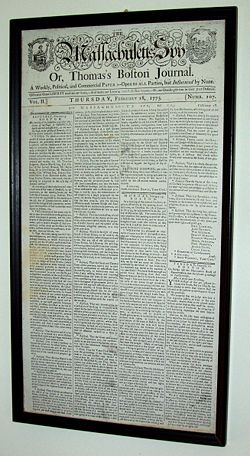
Sheffield Declaration
Encyclopedia

Colonial America
The colonial history of the United States covers the history from the start of European settlement and especially the history of the thirteen colonies of Britain until they declared independence in 1776. In the late 16th century, England, France, Spain and the Netherlands launched major...
n petition against British tyranny and manifesto for individual rights, drawn up as a series of resolves approved by the Town of Sheffield, Massachusetts
Sheffield, Massachusetts
Not to be confused with the city of Sheffield in the UK, or Sheffield, Vermont.Sheffield is a town in Berkshire County, Massachusetts, United States. It is part of the Pittsfield, Massachusetts Metropolitan Statistical Area. The population was 3,257 at the 2010 census. Sheffield is home to...
, on January 12, 1773 and printed in The Massachusetts Spy, Or, Thomas’s Boston Journal on February 18, 1773. The meeting took place in the Colonel John Ashley House
Colonel John Ashley House
The Colonel John Ashley House is a registered National Historic Landmark located on Cooper Hill Road, Sheffield, Massachusetts...
, a registered National Historic Landmark in Ashley Falls, a neighborhood of Sheffield, Massachusetts.
The resolves were debated and approved by a committee of eleven local citizens: Deacon Silas Kellog, Col. John Ashley (committee moderator), Dr. Lemuel Bernard, Aaron Root, Major John Fellows, Philip Callender, Capt. William Day, Deacon Ebenezer Smith Capt. Daniel Austin, Capt. Stephen Dewey and Theodore Sedgwick
Theodore Sedgwick
Theodore Sedgwick was an attorney, politician and jurist, who served in elected state government and as a Delegate to the Continental Congress, a US Representative, and a United States Senator from Massachusetts. He served as the fifth Speaker of the United States House of Representatives...
, who wrote the text.
The Declaration’s first resolution was that “Mankind in a state of nature are equal, free, and independent of each other, and have a right to the undisturbed enjoyment of their lives, their liberty and property,” These words are echoed in the most famous line of Thomas Jefferson’s Declaration of Indepedence three years later: “We hold these truths to be self-evident, that all men are created equal, that they are endowed by their Creator with certain unalienable Rights, that among these are Life, Liberty and the pursuit of Happiness.”
Further reading
- Brown, Richard D. "Massachusetts Towns Reply to the Boston Committee of Correspondence, 1773". The William and Mary Quarterly, Third Series, Vol. 25, No. 1 (Jan., 1968), pp. 22-39.
- Brown, Richard D. Revolutionary politics in Massachusetts: the Boston Committee of Correspondence and the towns, 1772–1774. Cambridge: Harvard University Press, 1970.

